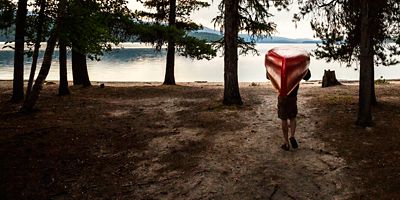Whether you’re tackling easy Class I-II whitewater, heading out on a loon-filled lake for a quick day-tour or extending miles for an overnight outing, the right strokes can spell the difference between a great time on the water and a grueling one. In fact, efficient paddle use is the foundation to any canoe trip. And, fortunately, it can be learned easily with just a little time on the water. Following are a few technique tips to get you paddling in the right direction.
Tandem vs. Solo
Most canoe strokes apply to both tandem and solo paddling. If paddling tandem, try to paddle on the opposite side of the canoe as your paddling partner; it’ll yield better stability and forward momentum, without the tendency to turn.
Forward Stroke
The forward stroke is the most fundamental and frequently used paddle stroke for canoeing, so gain an edge by doing it correctly. Designed to propel the canoe forward, the key is keeping the blade as close to vertical as possible in the water. To do so, lean forward at the waist, reaching out as far as you comfortably can, placing your (top) grip hand (which should be placed over the top of the T-grip) out over the water and keeping it at eye level throughout the stroke. Rotate the shoulder of your grip hand forward as you plant your blade, while rotating your other shoulder backwards, to help engage your whole core; as you pull the blade back toward you, the power should come from your torso, twisting as you return to an upright posture, instead of your arms.
Try keeping your arms straight (elbows close to locked) and you’ll see how that core-driven motion will result in less fatigue in the extremities as you push your grip hand forward while pulling with your (lower) shaft hand. Use your core and arms together to recover and bring the paddle forward again. Hint: End your stroke when it’s next to you rather than behind you for maximum efficiency.
Back Stroke
Use a back stroke to slow down and/or put the canoe in reverse; it’s good for stopping the canoe’s forward momentum on flat water, or slowing it down in moving water. If paddling tandem, it can also be used to help turn the boat (have one paddler take a back stroke on one side while the other takes a forward or sweep stroke on the opposite side). To perform it, reach back with both hands, put the blade in the water behind your waist and pull forward, keeping the blade-face perpendicular to the canoe. Hint: Rotate your torso to engage your midsection, pulling with your grip hand while pushing with your shaft hand.





